The Amateur Mycologist #32 - Hypholoma fasciculare - Sulfur Tufts - Plus Practical Safety Advice For Mushroom Foragers
These posts are not for foraging. They are intended for entertainment and intellectual satisfaction only. These posts are not a field guide nor comprehensive in any way - their accuracy is not assured in any way. Do not eat wild mushrooms unless you are a professional, have substantial professional assistance or have a wealth of personal experience with a specific species. Do not make any foraging decisions based on these posts. To do so could be dangerous or life threatening.
This particular post makes reference to toxicity and edibility only in order highlight the dangers of misidentification.
I've posted this in the #sndbox tag - after checkig out the content there and the @sndbox posts, i think my posts fit the bill. If not, let me know! Although I've been doing extremely well, I will be making some efforts to broaden the reach of the blog on Steemit.
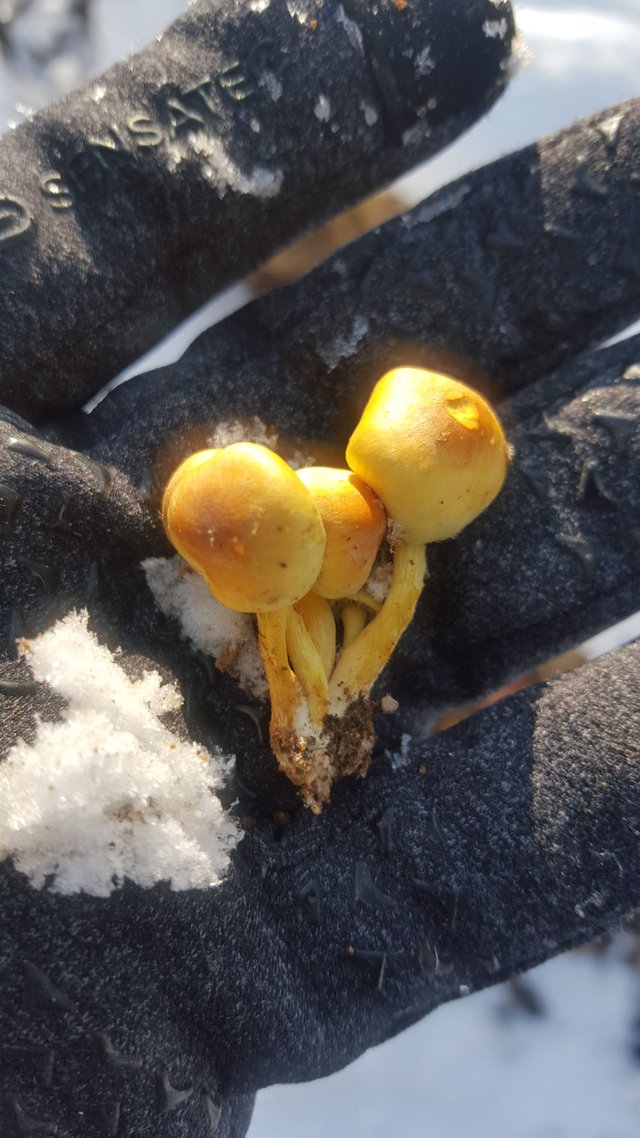
These pretty little yellow guys are Hypholoma fasciculare, or Sulfur Tufts
As frequent readers know well, I almost never mention anymore whether a given species of mushroom is edible or poisonous. However, I am going to make an exception with this post because the the way these sulfur tufts were growing presents a great teachable moment about the dangers of foraging for mushrooms as food.
Sulphur tufts are a poisonous mushroom. Specimens found in North America cause, at a minimum, terrible gastrointestinal distress. However the same species in Europe are anecdotally connected to deaths upon consumption. The result is that they are definitely a confirmed toxic species, and consumption should be considered potentially fatal depending on the specific mushroom.
It will become clear later in this post why I'm sharing this information. But, before we get into the teachable moment, let's learn what we can about this new species.
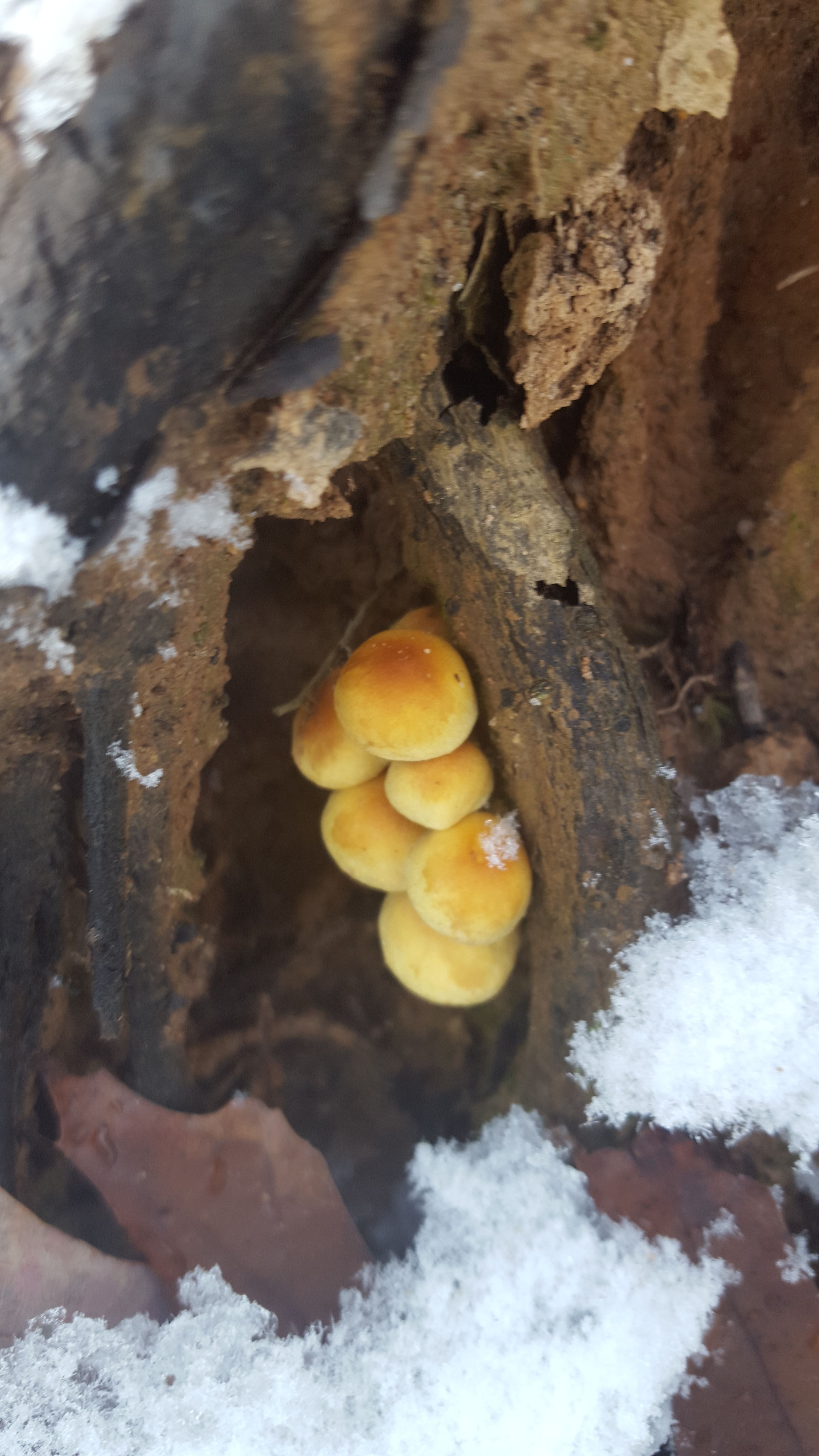
H.fasciculare is saprobic and grows on decomposing wood.
The mushroom tends to grow gregariously, in medium to large sized bunches. The caps begin, like these, fairly small and convex. I recently purchased a pair of digital calipers that will allow me to get more specific measurements for future specimens, but these guys averaged 2-3 cm in diameter and were all very young.
These caps were yellow, with a darker orangish center and dry to the touch. The caps expand substantially and become almost flat with maturity, as well as growing another couple of centimeters in width.
Let's pluck these guys and take a look at the stems and underside.
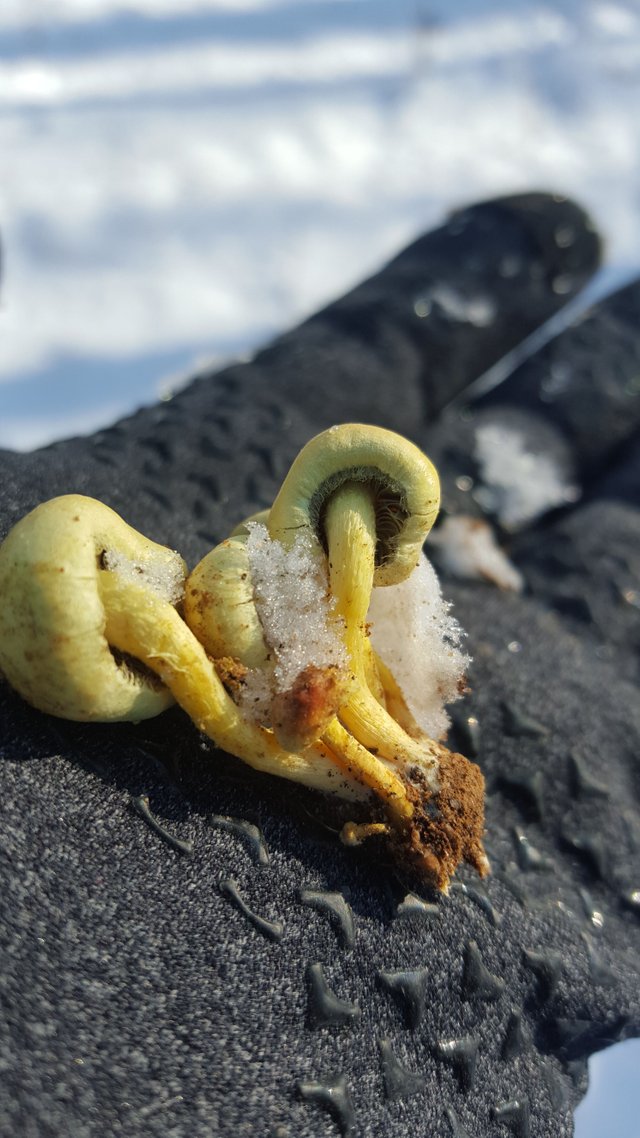
The yellow color extends to the stems as well as the cap.
The caps sometimes take on a green tint - while the young gills, which you can not see too well here, are yellowish, eventually darkening to an olive or olive-greenish color - although the mature cap below looks brownish in the photos as the gills near the center.
Note that these stems taper as they head to the base and, at their widest, are only about 1cm or so in diameter. This may not always be the case and they could be an even width all the way down.
Note also that there is a very slight cortina, or partial veil fragment, still lingering on the edge of the upmost cap. This cortina will sometimes leave a slight ring zone on the mature stem, although I don't think one was particularly visible here. This is to be expected as the ring zone does not always appear.
Take a look at an older cap.
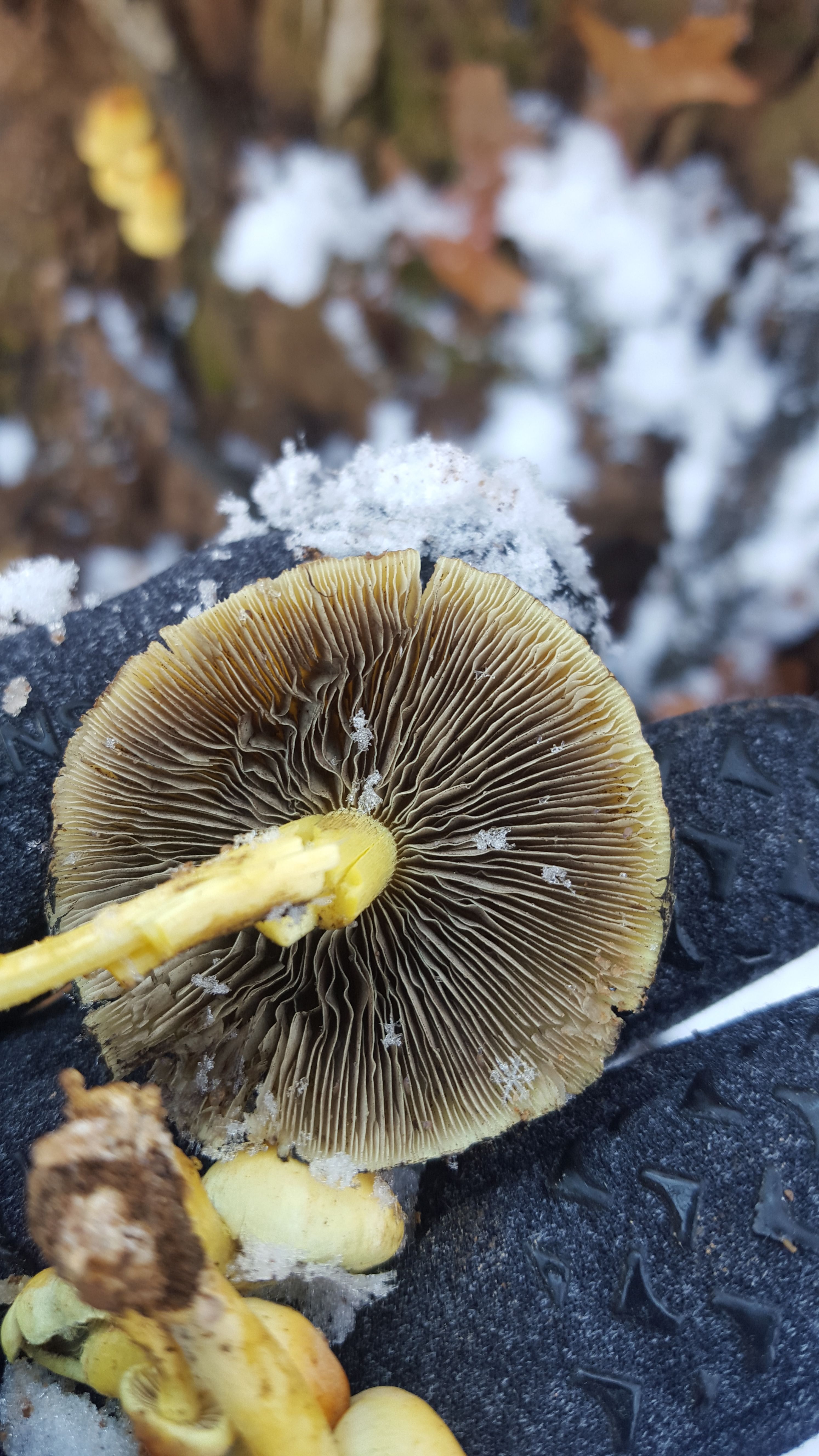
This older cap has crowded gills attached to the yellow stem, and has become almost entirely flat
The gills maintain their yellow color near the edge of the cap, but have darkened considerably nearer to the center. This is a combination of maturation and the coloration of the spores collecting on the gills.
The spores themselves are a heck of a surprise for those unfamiliar with this genus.
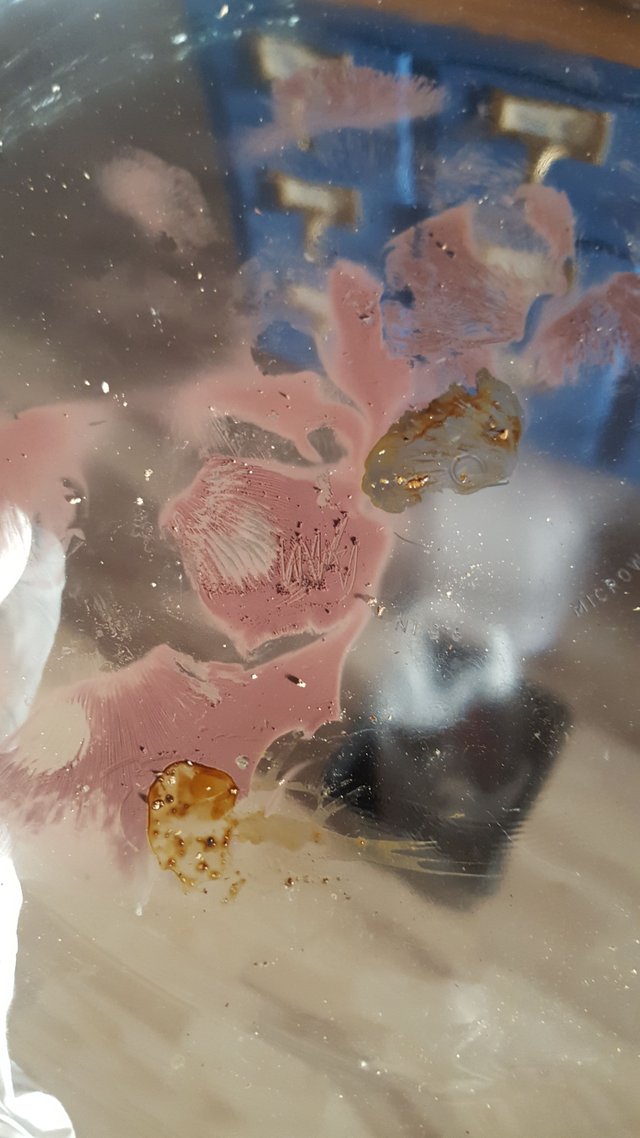
Purple spore prints out of a bright yellow mushroom!
You can see the bright purplish spore color has changed to a yellowish brown in two splotches where I placed a drop of KOH solution. This is also in keeping with the species.
At this point, if you've kept up with my posts, a lot of this information may seem weirdly familiar, especially this last photo. If you're a super fan (not sure how many of you are out there) then you may already see the teachable moment I'll be getting at soon.
First lets get this under a microscope
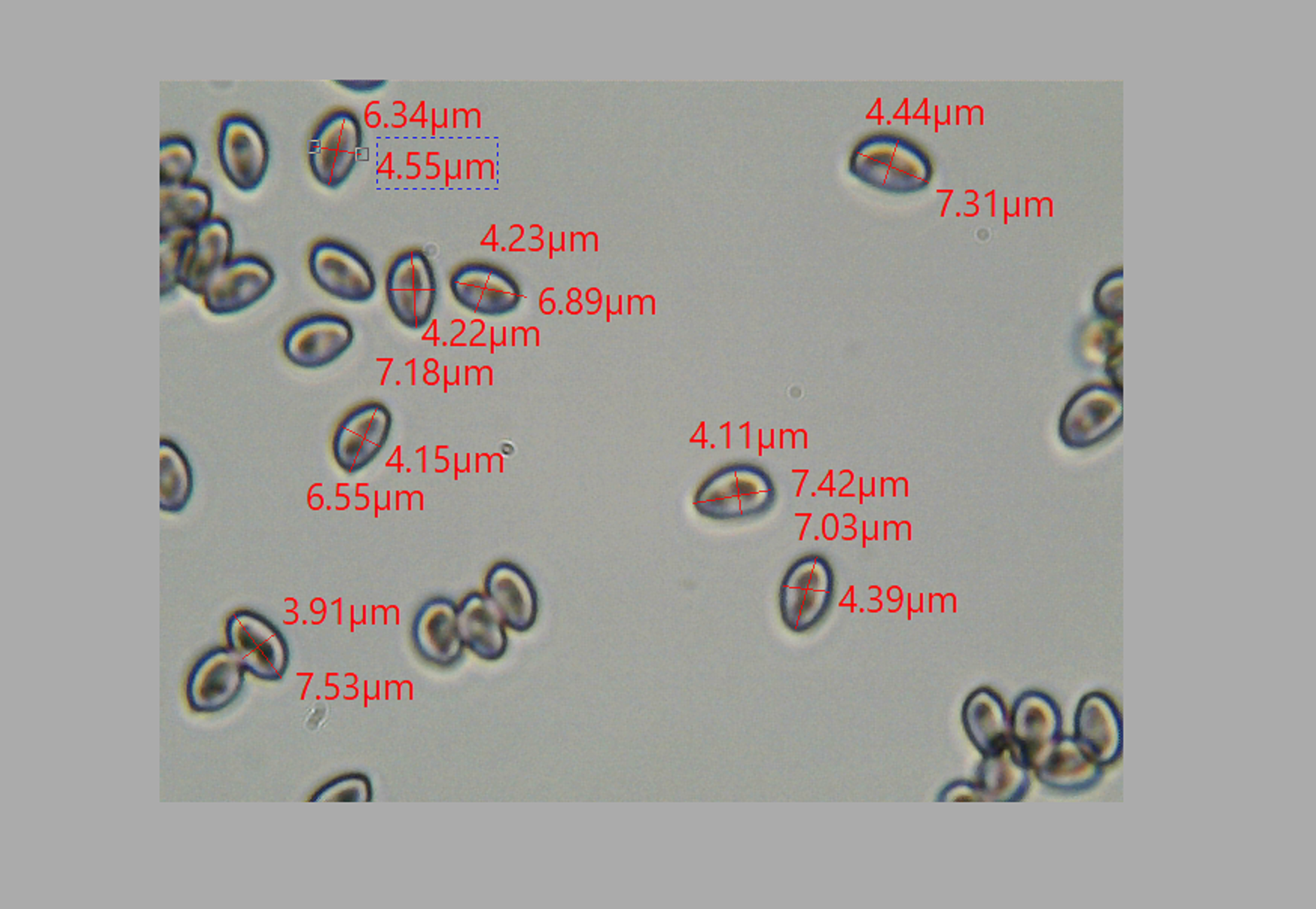
The spores are ellipsoid and appear smooth in my scope.
Of course, without an oil immersion lens, almost everything but extremely textured spores appears smooth. However, the measurements of the spores holds up perfectly to the various size estimates - in this case between 3.9-4.6 by 6.3- 7.5 microns. There is supposed to be a visible pore in the spores - which may or may not be the greenish blobs you see in this photo above inside of the spores. However, based on the spore color, discoloration to yellow, shape and size I'm fairly certain these fit the bill
It's worth noting that one more factor I could look for microscopically with this species would be looking for Cystidia on the gills under a scope. Unfortunately, because of the timing of my hunting them, I did not have the caps by the time I got home - nor did I have my hand lens that day - which is why we don't have any extreme closeups.
Now that we've gotten to know H.fasciculare fairly well, let's find out why this particular find presents a teachable moment.
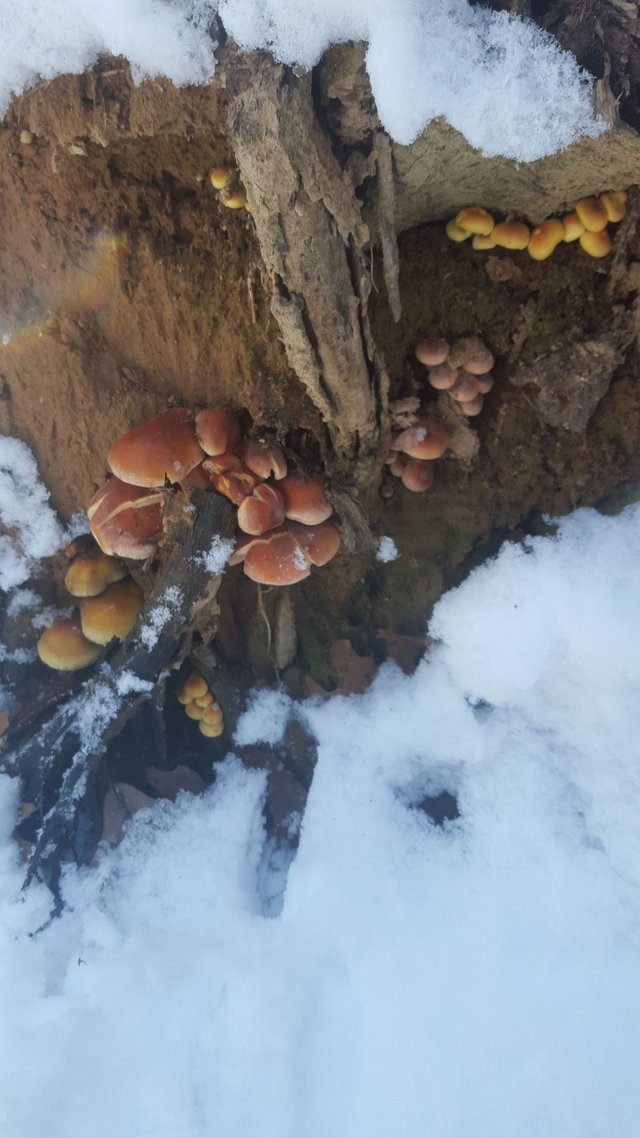
Here is the broader picture of the dead wood where I found these sulfur tuft mushrooms.
As you can see, the log is positively crawling with fungi - but it is home to more than just the H.fasciculare! The Sulfur Tufts can be found in the top right, top-center left and bottom left of the photo. You can distinguish them by their much yellower coloration.
However, through the center of the log a very different mushroom is growing - Hypholoma sublateritium, or "Brick Caps" I did a species psot about H.sublateritium last month, when I found these species growing in several disparate logs in the same area. Well, it so happens that these sulfur tufts were also found in the same natural area - and they happened to be growing on the same exact log as the H.sublateritium specimens.
Which brings us to the big lesson here: just how easy it is to get lazy and accidentally poison yourself while foraging for mushrooms.
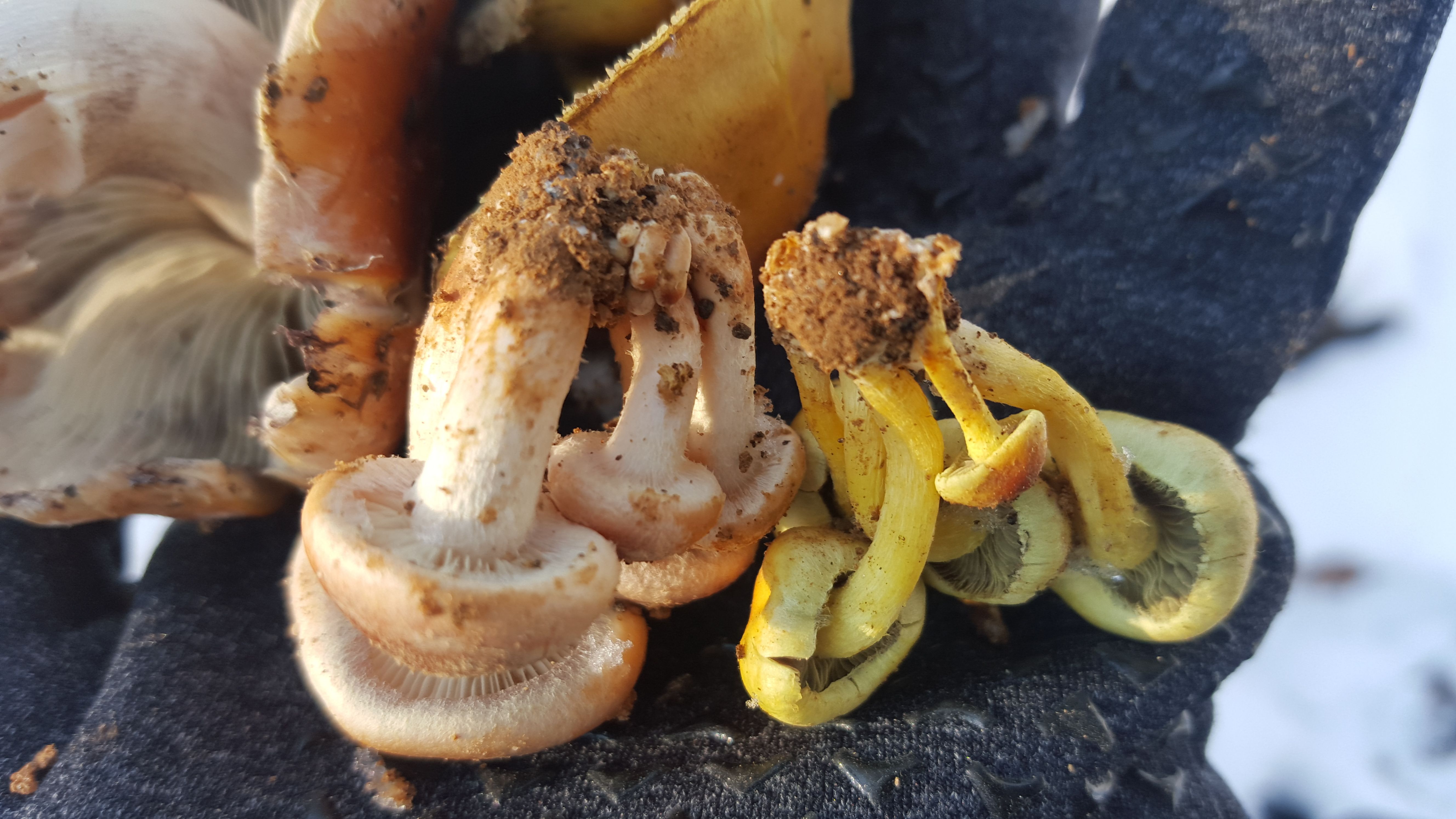
The mushrooms on the right are sulphur tufts, while the mushrooms on the left are Brick Caps.
In this photo the two mushrooms are fairly easy to distinguish - the former being much yellower with a thinner stem, the latter being brick colored with a thicker white stem.
However, if you were to eagerly pick the Brick Caps off this log, placing them all together in a bag or basket, it would be fairly easy to accidentally include some of the sulfur tufts, and not even notice.
The photo might already be confusing to some, but take a look at this photo
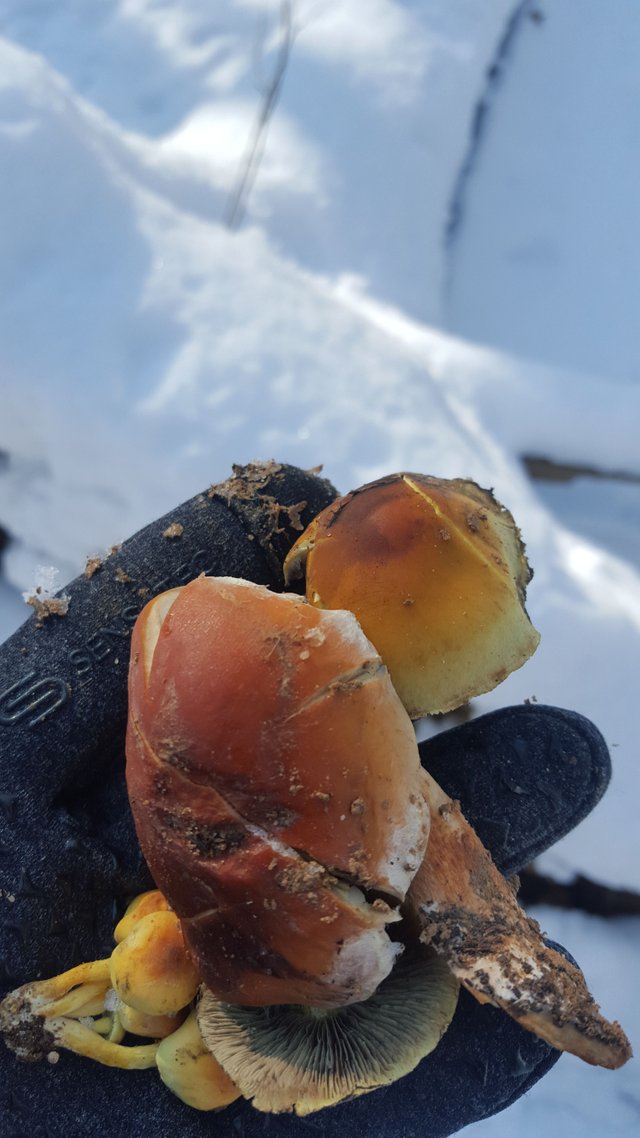
Looking at these mushroom from the cap side, it is significantly harder to distinguish the two species.
Yes, the mushrooms in the lower left are sulphur tufts - but so is the cap on the upper right of the photo! This may still seem fairly obvious to you - or it might not. Keep in mind, when foraging for mushrooms you will often be filling a large basket or satchel of some kind with your finds - and it would only take one sulfur tuft in the whole batch to result in an accidental poisoning.
Things don't get simpler once you get the mushrooms home, because they share many of the same characteristics. Both stain a brown color on the cap with KOH and have purplish spores which stain yellowish brown in KOH. Microscopically both species have ellipsoid spores in roughly the same measurement range. Indeed, mistaking these two mushrooms, at a glance, for each, makes a degree of sense, as they are essentially cousins and, in this case, growing extremely proximate to one another.
Unfortunately, that kind of mistake is as easy to make as it could be disastrous in its effect.
Takeaway:
I talked about the toxicity of Sulfur Tufts in order to illustrate a point: There are many mushrooms with poisonous lookalikes that often grow in the same medium, sometimes side by side. Sometimes a deadly mushroom will grow right next to an edible one. The lesson remains the same for them all - never let down your guard if you make the decision to forage mushrooms for sustenance. It only takes a small slip up to wreak potentially life changing havoc on your body. This is why I take a super conservative view on foraging and encourage everyone who reads these posts to do the same. If you want to eat your finds, get in touch with a local expert or mycological society and learn from people with local knowledge, in person.
MUSHROOM CHARACTERISTICCS
Cap = 2-8 cm wide - usually a bright yellow with a darker center - these were smooth and dry, some describe as possibly moist. These were yellow, some describe as greenish-yellow. Look at the edge of the cap - the margin - in younger specimens and you will usually see a small wispy cortina or remnants of a partial veil.
Flesh = yellow
Stem ("stipe") = about 1cm in diameter - anywhere from 3 to 12cm long, although these maxed out under 10 cm. Yellow, in this case tapering out near the base of the cluster. Sometimes the veil will leave a faint ring-zone on the stem - but often not, as in the case of the ones I found here.
Spore Print = Multiple sources call it purple brown - but both the Hypholoma species I've seen left a print I would just call purple. However, since all parties assert purple-brown, for the most part, I would keep open the possibility of a slightly more brown character to the spores sometimes.
Ecology ("How it grows.") = Saprobic, growing on decomposing wood. In terms of whether it appreciates confiners or hardwoods, expect either as a possibility. The forest I found these in was almost all hardwoods. However two sources - Kuo and Messiah college - say it prefers conifers - first-nature says it prefers broad leaved trees - and Lincoff simplifies it by saying "logs and stumps". I think, given my experience and the mixed signals on this issue, "logs and stumps" is the best advice.
Distribution = Throughout North America and Europe at least.
- KOH reactivity = The purple spore mass turns yellowish brown in KOH and the cap discolors brown as well.
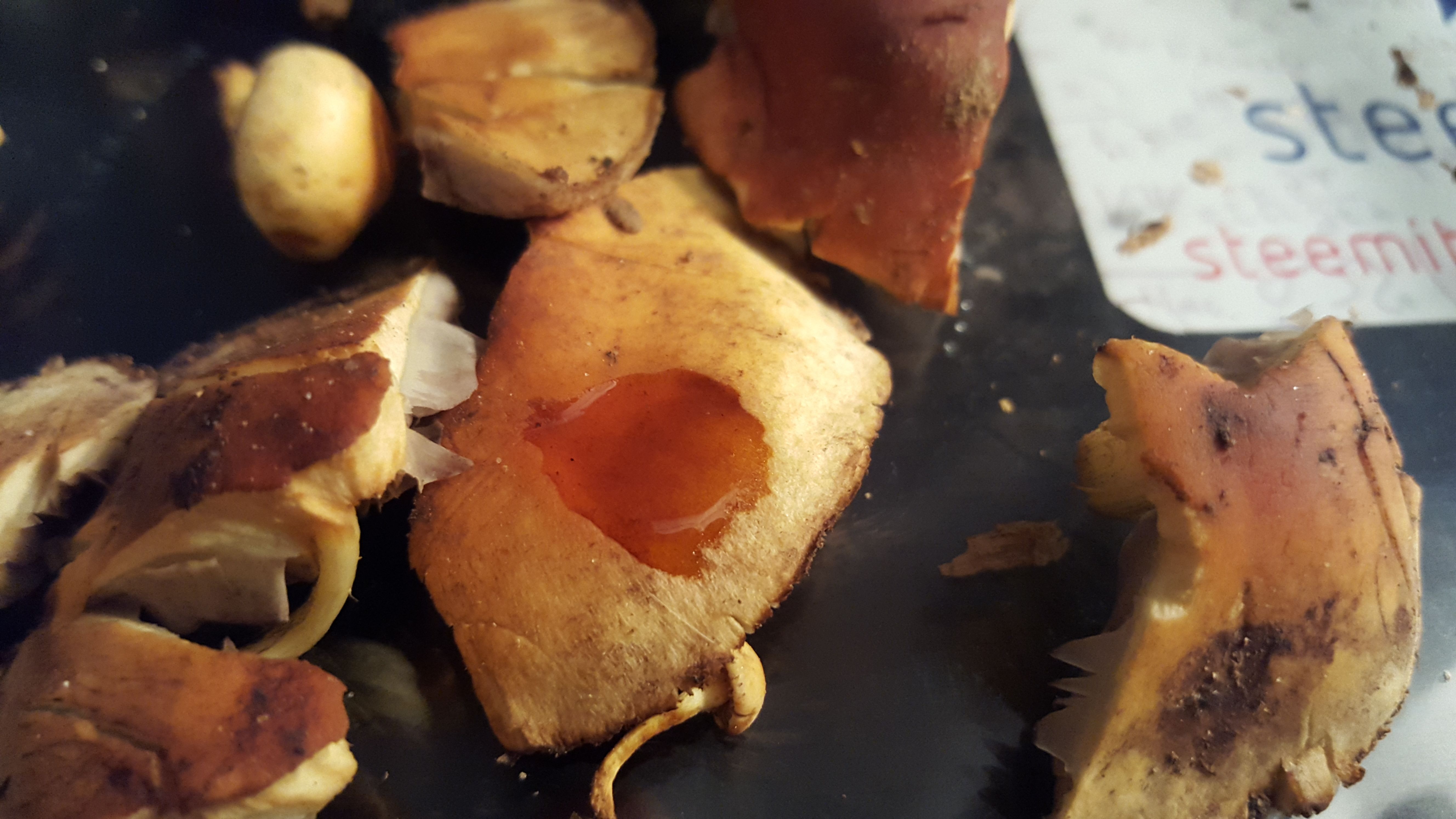
Microscopic Traits = Spores were ellipsoid and ranged in size here from 3.9-4.6 by 6.3- 7.5 microns, although the ranges are probably larger overall. My microscope is not good enough to directly observe for certain - but the spores should also be smooth and have a "pore" - but I am not sure what that looks like visually without an oil immersion lens. Keep in mind, Brick Caps share similar microscopic traits, so I would not rely on these two distinguish between the two.
Other = Apparently the Hypholoma genus has been the cause of some taxonomic confusion over the years and many of its members have switched around now and again to other genuses. For that reason, you may find H.fasciculare referred to as Naematoloma fasciculare - as in the Audobon guide - but they are the same species. Poisonous - at least gastro-intestinal distress in the US - but possibly also deadly based on European reports.
Edit:
@plotbot2015 made a great point - what would happen if someone was red/green color deficient?
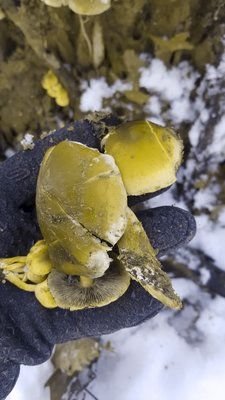
Total confusion! Excellent point @plotbot2015! Individuals suffering from color blindness are at a severe disadvantage in the identification of mushrooms.
THIS POST IS NOT INTENDED FOR FORAGING PURPOSES AND TO USE IT FOR THOSE PURPOSES WOULD BE DANGEROUS. DO NOT HUNT WILD MUSHROOMS WITHOUT RELYING ON A COMBINATION OF PROFESSIONAL FIELD GUIDES, IN PERSON PROFESSIONAL GUIDANCE, OR IN PERSON GUIDANCE BY SOMEONE TRUSTWORTHY WHO HAS COPIOUS LOCAL, SPECIALIZED MUSHROOM HUNTING EXPERIENCE. FAILURE TO DO SO CAN RESULT IN GRIEVOUS PERSONAL HARM OR DEATH.
Photos Are My Own
Microscopic photos were taken using an AMScope M150B entry level microscope. If you use microscopes, I'm quite sure you've never heard of this model - but its cheap and available on Amazon. The camera lens is also AMScope, MD35 - by far their crappiest microscope camera. But, still capable of material, relevant, and in some cases, dispositive, data collection. Lastly it should be noted that the precise magnifications are not easily deduced using the camera - but based on relative spore sizes compared to known microscopic photos from Kuo and other sources, I estimate 40, 100 and 400x.
Information Sources
[1][Gary Lincoff, Audobon Society North American Mushroom Field Guide, Naematoloma fasciculare, p.709]
[2]Kuo, M. (2014, February). Hypholoma fasciculare. Retrieved from the MushroomExpert.Com
[3]First-nature on H. fasciculare
I did a series of nature identification posts a while back, and while I was happy to take a shot at identifying any plant, animal, or rock, I took your lead and was extremely conservative about fungi identifications- if there was any doubt in my mind I'd refuse to identify it, and I always warned people not to take my word for it. (I think I only ever got one, though, and it wasn't even a mushroom.) I'm good at amateur IDing stuff, but I am still an amateur at everything but rocks.
When i first started the blog I had disclaimers but not as boldly and unequivocally as i do now. At the time I was worried they might detract from readership. And maybe I was right - but I don't care. Safety really needs to come first, which is the same reason I almost never discuss edibility except to make a point about safety as i've done here. End of the day, I am an amateur in every sense of the word - and I'm not shy about it, or my ability to make mistakes - which is why NO ONE should be making edibility or foraging decisions on my posts, unless it encourages you NOT to forage.
The only way to learn with the degree of security necessary to safely and consistently forage for food is with large informed groups and/or professionals. My primarily auto-didact studies mean I never eat my wild finds, even if I'm very comfortable with my ID. I encourage everyone to hold themselves to the same standards.
Exactly. Despite the many people who think you can learn anything off of the internet, some things can ONLY be learned through hands on training by experts and field experience. In addition, the google mindset, for all its advantages, has the effect of badly devaluing metis, local knowledge.
VERY WISE ♦♦ Good advice to people ♦♦ Hope Everybody reads THIS !
Major Upvote (I did), in the HOPE people WILL READ THIS .
I apreciate such a great work. Few people like you. Keep writing complex detailed posts. Good job !!
Thanks @azen - they take a lot of effort but I enjoy writing them.
yeah, still love reading through your mushroom "exposés". I wish you a Happy New Year, and look forward to many more of these terrific posts! :)
Thanks Alex - and happy new year to you too!
Glad to hear that :)
thank you so much for sharing these interesting and useful stuffs.....
keep posting.....
Nice post! We can easily conceptualize that mushroom foraging can be dangerous due to lookalikes, but it's far more satisfying to have a solid example of lookalikes, like this post. Furthermore, these poisonous shrooms like to live with their lookalikes and have the same purplish spores.... even look similar under a microscope!
Absolutely - it's easy enough to talk about confusing lookalikes, but it's rarer to be able to point out the perfect example.
Always appreciate your fine work. As usually - incredible shots! It's very cool to be able to appreciate the fine details in this beautiful little fungi.
There's always more to learn and see. Thanks for sticking around through the more obscure slime molds.
And that is why I am not ready to forage any gilled mushrooms.
Definitely find a local group of enthusiasts and go out with them. Foraging and eating mushrooms with a group you trust is an amazing experience. Going it alone based on internet blogs, less so :)
That's something I would like to try, right now I am just sticking with polypore mushrooms.
A good place to start - but if you forage others just to learn and not to eat theres nothing to lose!
I was on a big kick of taking pictures of mushrooms for a while, perhaps I will post some up.
Definitely - get on steepshot too - instagram like app on the blockchain
I thought I heard that wood loving mushrooms were mostly edible. I'm glad you got me the facts before I spread inaccurate data.
Oh, I wouldn't rely on that at all :)
One example immediately jumps to mind that is deadly poisonous - Galerina autumnalis or the Deadly Galerina. This mushroom is most frequently mistaken for Flammulina velutipes. They don't look a ton alike, but if circumstances conspire against you they can start to meet in the middle. Volk recommends a spore print for every single F.velutipe one harvests just to protect against possible mistakes.
The only general rule of thumb one should take seriously with fungi and edibility is that there are no sufficiently reliable general rules of thumb.
This is an excellent post, detailed but focused and not at all rambly (the way mine sometimes turn out).
What struck me most was thinking about color vision. In these particular photos, the differences between yellow and brown were pretty obvious (to me), but someone who has difficulty on the red-green axis might have a very different view. One way to check would be to upload these photos to http://www.vischeck.com/examples/ and see if they get harder to distinguish.
Wow! You were not kidding! Look at this!
A person suffering with red/yellow colorblindness would find these indistinguishable from some angles - excellent insight - I will update the article with this image!
"Your friendly neighborhood neuroscientist" is happy to be of service.
Great photos and awesome post. Thank you so much. I love mycology but sadly don't have the time to truly delve in to it as much as I would like.
Just start looking down everywhere you go and soon enough the delving will begin....the bad news is you'll never be able to walk around like a normal person again :)
Nice article..thanks